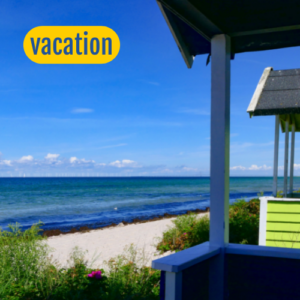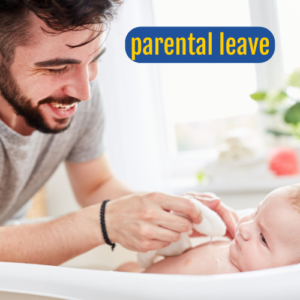If you talk to someone, especially an American, that have worked in Sweden for some time one of the things you probably will hear is that Sweden has a fantastic work-life balance.
But what does that mean, what is it Sweden do so well and why?
Hejsan Hej, I am PixelPia and this is A Swedish Fika, the podcast where I talk about Sweden and Swedes from many different perspectives. And today I want to talk about work-life balance in Sweden.

Lagom and work-life balance
But I want to start by talking about the Swedish expression Lagom and how it has impacted the Swedish way of looking at work-life balance.
Lagom means means “not too much, not too little”, “just enough” or “good enough”, depending on the context. At its core, lagom favors moderation over excess. The concept of lagom is visible in all parts of life in Sweden, and of course, it has affected the work-life balance as well.
I read a fascinating interview with Lotta Dellve, a professor at Gothenburg University. She has studied Swedish working conditions since the 1990s and has produced prize-winning research on how businesses can create sustainable environments where employees thrive.
She defines lagom as;
“In everyday speech, we use lagom to express that we believe something is just right. At work, this means performing well enough according to a balance between my resources and what my job needs from me.
A central aspect of lagom refers to having a work-life balance. This means to put lagom efforts into work, to have time to recover after
If you find your level of lagom, you will be able to get good nights of sleep, spend time with your family or friends, and exercise. If you get to rest every day, spend time with the family, and exercise, you will be able to work better and for more years..”
She also talks about how this is beneficiary for the companies both when it comes to education and leadership;
“Another point of success is that lagom encourages continuous learning. Employees can be more creative, which will make them more satisfied. This is really important. The more learning – individual and collective – there is in a business, the better for the business.
manager telling the employees what to do. We already tried this kind of management in Sweden for a period of around 15 years. We saw an increased level of sick leave and less engagement among employees, which is why we now try to switch back to a more collaborative leadership style based on building trust in the workplace. As a result, we have seen an increased level of work engagement among employees.”
But what are the factors that create this balance between work and the rest of your life? Today I will talk about four aspects of the work-life balance.
Working hours
Sick days and care of children
Vacations
Parental leave
Working hours

The average amount of hours spent working in the US is more than 50 per week. In Sweden, the normal workweek is 40 hours, and there are laws regulating how much overtime you can do with a limit of 48 hours per week. Of course, this is not true for all employees in Sweden, and many in a management position work more than 40 hours by taking work home with them.
Working overtime, in general, is not valued and can even be seen as an indication of poor planning and time management.
Another very common thing in Sweden is the flexible working hours, known as flextid (flex time) which means that if your standard work hours are between 8 and 5 you are only required to be physically present between 9-4 or sometimes even 10-3, and you manage the rest of the hours according to what fits best for your life and circumstances. For example, you make a dentist appointment at 4:30 on a Tuesday, you leave work at 4 that day, to make up for that hour you can work 8-6 the next day.
And even before the pandemic, it wasn’t unusual for companies in Sweden to offer their employees the opportunity to work from home if it was doable with the type of work they were doing. One of my brothers has worked partly from home since early 2000, just to avoid the commute.
All of this is of course depends on what kind of work you do. Not all occupations are suitable for flexible work hours or work from home. But one thing every employee in Sweden have regardless of the type of work is
Sick days and care of children

Every employee in Sweden has the right to sick days. And there is no set number you can get, but there are some requirements after a certain number of days. I will not go into detail here. I will also say that due to the coronavirus outbreak, several temporary changes to normal sick pay rules are currently in place.
But in general, if you get sick you just contact your employer to let them know, for the first sick day you get paid nothing, but for the rest of the first 15 days, you will get 80 % of your regular pay, which is paid by the employer. After 7 days you need to get a doctor’s note confirming that you are still sick. The Försäkringskassan (the Swedish Social Insurance Agency) is paying 80 % of your salary after the first 15 days.
There are also many exceptions and special circumstances for all sick leave after 15 days, one that I took advantage of when I lived in Sweden was;
If the employee can work, but cannot get to work in a usual manner, they can request an allowance for additional expenses for travel to and from work instead of sickness benefit.
This was beak in the mid-90s and I was working as a teacher. I lived in the south suburbs of Stockholm and worked in the north at the time I went to work by bus and subway. One morning on my way to work I got my foot stuck on the floor in the subway and twisted my ankle, or so I thought, I went on to work but when I got there I realized that my ankle was not just twisted, and a college drove me to the nearby hospital. After getting my leg x-rayed it was confirmed that I had broken my ankle. So nothing left to do but put on a cast and stay off my feet for at least two weeks. After two weeks I got a heel on my cast and was allowed to put weight on my leg again. At that point, instead of using the sickness benefits, it was arranged for me to get a taxi to drive me to and from work. I could return to work after two weeks jumping around on my cast thank to the transportation.
Besides the right to your own sick days, parents have the right to stay home to take care of their sick children. This is called Vård Av Barn VAB, or “care of child”. You have the right of 120 days per child and year up till the age of 12. When you are home taking care of your sick child the Försäkringskassan pays 80 % of your salary, the same as when you are sick yourself. The word has even become a verb to VABBA.
Vacation

Another aspect of work-life balance is everybody’s right to vacation. According to the Annual Leave Act, you are entitled to 25 full days of vacation every year regardless of your age or type of employment.
If you are working irregular hours or part-time, your annual vacation is recalculated to the equivalent of 25 days.
You are also entitled to a continuous vacation of four weeks (main vacation) during the period of June to August with some exceptions.
In order to receive vacation pay, you must first have earned your right to such pay during a qualifying year. This runs from 1 April until 31 March the year after that. If you have been an employee throughout the entire qualifying year, you will have earned your right to vacation pay for all of your annual vacation days. Your vacation pay will usually consist of your ordinary monthly salary and a daily vacation-pay increment. Vacation pay is calculated as the daily rate paid to the employee plus a premium of 0.43% of their monthly pay. So you actually get higher pay during your vacation.
If you have only been an employee for part of the qualifying year, then some of your vacation days will be unpaid – that is, you will not receive any vacation pay for those days.
According to the Annual Leave Act, if you are unlucky enough to be taken ill during your annual vacation, you have the right to end your vacation and instead take your vacation on another occasion
If you have an annual vacation of 20 days or more, you have the right to save your vacation days during a period of five years and convert these into one continuous vacation.
If you start your new employment after 31 August in any given year, you will only be entitled to 5 full days of vacation until 1 April the following year.
Parental Leave

I talked about parental leave a bit in my last episode, Meet the Andersson’s, so I will just give you a brief overview here.
Parents have the right to 480 days of parental leave. 90 of those are reserved for each of the parents, the rest can be divided as they feel most comfortable with.
For the first 390 days, you receive 80 % of your salary paid by Försäkringskassan, and for the last 90, you will get around $20/day.
Conclusion
All of these factors have helped Sweden build a healthy balance between work and life. On average the Swede spends more than 15 hours per day in leisure and sleeping and only 1 % of Swedes work more than 50 hours per week.
It is very unusual for a typical Swedish company to contact their employees outside of work hours, if not absolutely necessary.
Swedes cherish their time outside of work and keeping a healthy boundary between free time and work is important for your health and your mental well-being.
I hope you found this topic interesting. In my next episode, I will talk about Sweden’s five national minorities. If that sounds interesting to you I hope you will subscribe to A Swedish Fika. If you want more information you can sign up for my newsletter at aswedishfika.com
And now, as we say in Sweden
Hej Då





One thought on “Work-Life balance in Sweden”